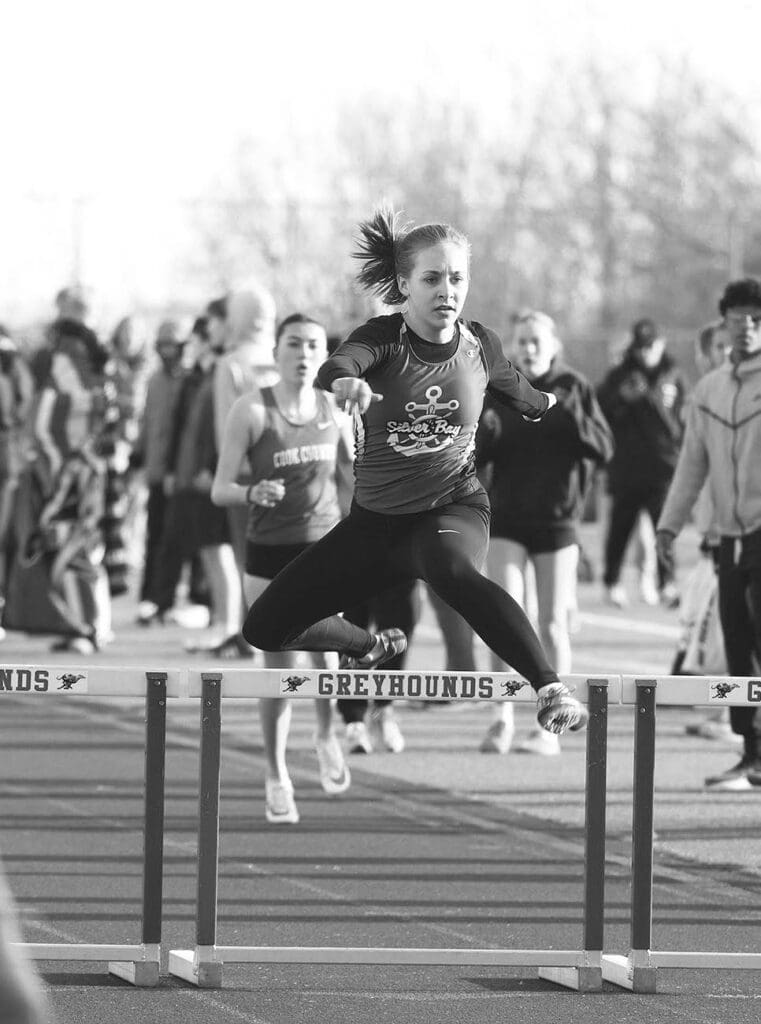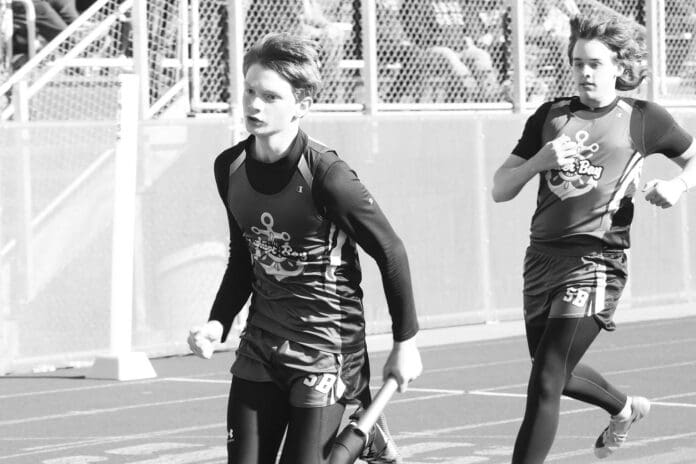Just three years after he began teaching in Silver Bay, Rick Frericks stepped into the role of head coach for the Track and Field team. That was in 1995.
“I was in track in high school and college, so I’ve always enjoyed and followed track. Then I started coaching — and I haven’t stopped,” he said.
Thirty years later, track and field remains a passion for Frericks.
“That’s the biggest thing I enjoy,” he explained. “I enjoy the kids. I enjoy the sport. I’ve always liked track meets and getting kids ready for them — preparing training plans, working on strategy, all of that.”

And he’s not the only one having fun. The program’s popularity has nearly doubled in the past three years, growing from 23 athletes in 2023 to 41 this season, covering grades 7–12.
“In the last couple of years, the program has just exploded,” he said. “Those numbers are tremendous. Maybe it’s just that some of the kids we have are good recruiters and their friends come out. It’s been a lot of fun to have all those kids out there.”
With a larger team, Frericks expressed gratitude for the support he has from assistant coach Kerri Bilben, who has been with the team for over a decade, and two parent volunteers, Alaina Melander and Evan Swartz.
“With that number, we need a little bit more help,” Frericks said. “They’re taking a nice role, and I appreciate them. They’re doing a great job.”
As important as strong coaching is, leadership among the athletes is equally crucial — something the Mariners have, particularly with their five seniors.
“We have some really nice leaders on the team with Ayden Althaus and Knecrid Lahti,” Frericks said. “Jacob Carpenter is a tremendous athlete — he runs track and plays baseball, juggling both and doing a nice job. Remy Braun has been around for a number of years and has been great. Ethan Meeks just came out last year and he’s really done a nice job. On the girls’ side, we have Britta Swanson, who is our only senior.”
Frericks is both proud of and deeply grateful for the seniors on the team, recognizing the important role they play in setting the tone for the entire program. He praised their leadership, work ethic, and positive example, noting how their presence helps elevate the team’s spirit and performance.
“They lead by example,” he said, emphasizing how valuable it is to have older, experienced athletes who not only perform well but also inspire and guide their younger teammates. For Frericks, having strong senior leadership isn’t just a bonus—it’s a key part of building a successful and supportive track and field community.
“I always feel like if I’ve got a bunch of seniors, it just really seems to help the team. Historically, they’ve been good leaders. They’re also older, so they tend to be pretty good athletes, too,” he said.
Veteran runners like junior Val Melander and sophomore Sierra Geatz — who have been on the team since seventh grade — help to spearhead the girls’ side as well.
“We’ve got some really nice young athletes coming up, too, so that’s exciting,” said Frericks. “Especially Sophia Schut — she can run multiple events and do well. And Ivy Aldinger, she’s an eighth grader who did well at sections last year in the 200 and made sections in both the 100 and 200. She even placed in the 200 as a seventh grader — that was really good!”
Another seventh grader making waves is Sam Swartz, who Frericks reports is already running strong times. His older brother Nick leads the distance runners.
“He’s such a good role model for them,” Frericks said, of the junior. “He’s going to be competitive at sections in both the 1600 and 3200.”
Early in the season, figuring out where athletes can be most competitive is part of the process — especially with this spring’s uncooperative weather limiting outdoor meets.
“We try to put people in places where they can either go to sections or state,” Frericks said. “Now that we’re getting some meets under our belt, we’re seeing how they compete against other kids in their section. Each meet gives us more information so kids can lock in on where they want to focus their energy for subsections and sections. That’s the fun part. The fun part is happening now with the meets and helping kids talk through what events they want to really focus on.”
The coaching staff also studies how their athletes stack up against the competition.
“It’s kind of a chess match to a certain degree,” Frericks explained. “We still have a lot of time — a little under a month until subsections — and a lot of meets happening between now and then. We’ll get a good idea of the best fit for everyone.”
Despite its growth, the team remains tight-knit, something Frericks partly attributes to the co-ed nature of the practices.
“Other than cross-country, this is the only sport in Silver Bay where practices are co-ed. The guys and girls practice together. The guys and girls ride on the bus together. So, I think that also helps in terms of keeping the kids getting along with each other,” he said.
Beyond the team, there’s a strong and shared sense of community woven into the very fabric of the sport itself. Track and field creates connections not just among teammates, but across schools and competitors, bringing together athletes, coaches, and families who all share a respect for the hard work and dedication it demands. It’s a sport where encouragement and camaraderie are just as important as competition, fostering an environment where everyone supports each other’s efforts and celebrates each other’s growth.
“Everybody’s working hard so there is a camaraderie that is formed when people are working hard together,” said the coach. “Quite often with some of these work outs, you’re working hard and you’re not feeling very comfortable. There are quite a few people that would avoid something like that because they don’t want to really stress and challenge their body. It takes a certain kind of person to be able to do that and be fine with it.”
That spirit of support doesn’t stop within team boundaries — it extends across schools and competitors as well. At meets, it’s common to see athletes cheering for rivals and friendships forming beyond school colors. It’s a reminder that in track and field, while the competition is real, so is the respect and amity that binds everyone together.
“You go to meets and people are cheering for other people not even on their team,” said Frericks. “People support each other. Coaches support each other. It’s not cutthroat. It is a very welcoming environment. People are just happy to be there and just everyone’s working hard, so everybody supports each other, but they also compete against each other, too. They want to beat them, but they get off the track and they’re friendly and everything’s fine.”
One of the unique aspects of track and field is that it challenges athletes to compete not only against their opponents, but also against their own personal bests.
“You could have eight people running in a race, and when they finish, they’re all happy,” Frericks said. “Even the eighth-place runner, because maybe they set a personal record. There are so many opportunities for success, not just against other people, but within yourself.”
For Frericks, track and field is more than just a season — it’s the beginning of a lifelong relationship with fitness.
“Taking care of our bodies is a lifelong challenge. Track is a very good way to begin that journey. And it doesn’t even have to be running – even if they are walking, they’re moving. That’s really what I also want for them: to develop some lifelong skills with exercising.”
Best of luck to the Mariners Track and Field Team this season!



